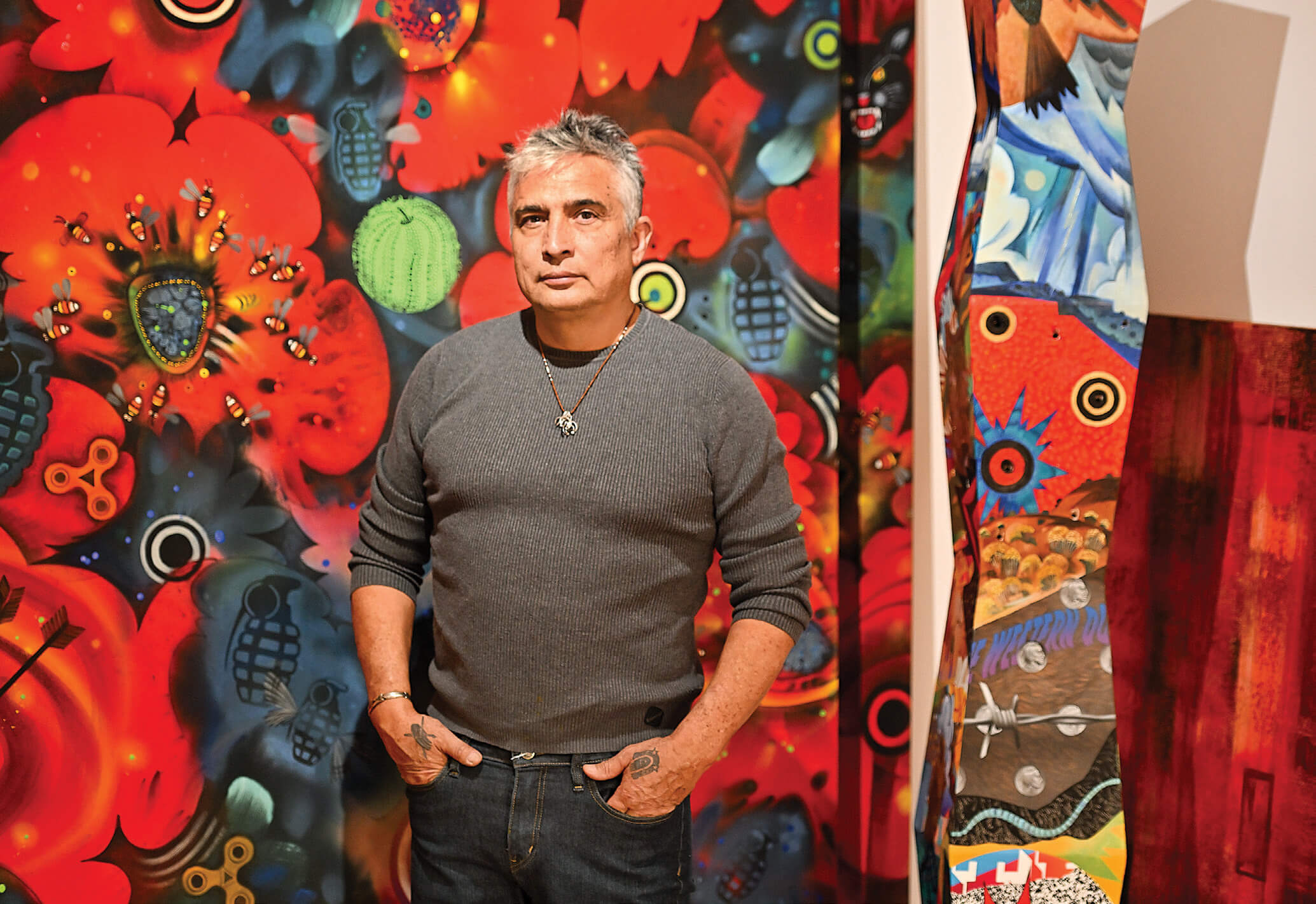
06 Jul In the Studio: Engaged and immersed
Within the first 10 minutes of the 2023 Masters of the American West exhibition at the Autry Museum in Los Angeles, artist Tony Abeyta sold all of his paintings.
This sounds remarkable, but it is, in fact, a typical experience for the artist at this and many other premier art shows. His work resonates with collectors who find that his striking landscape paintings are created by someone deeply connected to the subject.
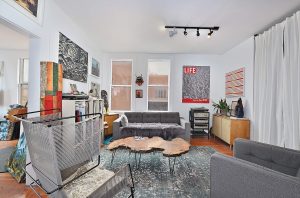
Abeyta’s comfortable studio features works by artist friends, including Steven Paul Judd, who created the imagery for the LIFE magazine cover.
“My personal spirituality comes from the land,” Abeyta says. “As an environmentalist, I realize that a sense of place and cultural belonging is in the land and its historical narrative.”
Born in 1965, Abeyta grew up in Gallup, New Mexico. His father was a Navajo Code Talker in the Pacific Theater during World War II and also an artist. Abeyta was exposed to art at a young age, leading him to seek an art education.

Alongside Abeyta’s black and white paintings are two pieces by artist Craig George.
He attended the Institute of American Indian Arts in Santa Fe, New Mexico, earning an Associate of Arts Degree in 1986. He says the experience was life-changing, and the interaction with students from across the U.S. — from numerous tribes as well as the familiar Navajo Nation and nearby Pueblos — influenced him the most. “We all shared similar values and origins, but we had different approaches; I learned about the different iconography for each tribe. Discovering the experiences of so many different Native Americans, along with the impact that all of us were there to study art — not science, not law, not business, but our sole focus was art — allowed me to find my voice as an artist.”
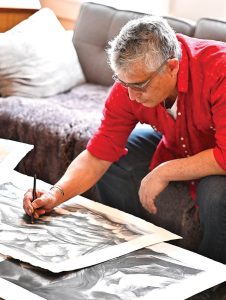
Intermittently, Abeyta breaks away from color to work in monochrome; several works in charcoal and ink wash on paper will be part of his August show.
Another significant influence in Abeyta’s career included his time in Europe, specifically in Italy and France, where his beliefs about art changed. He lived in Venice and also earned his Master of Fine Arts from New York University’s campus in Florence.
“I’ve had a relationship with Italy for a number of years — I love Northern Italy — the Alpine region including Lago di Como and Lago di Garda, the well-known lakes of the region,” he says. “I go back and forth because my son lived in Barcelona, now in Nashville, and my daughter lives in Amsterdam. So we could easily connect as a family in Italy.”

The new works in the upcoming show at Santa Fe’s The Owings Gallery are based on colors, shapes, forms, and geometrical planes, such as the untitled painting Abeyta works on here.
Abeyta is well known in the Southwest and West, where he maintains studios in Santa Fe and Oakland, California, but his gallery representation extends to Paris, and his frequent travels have earned him collectors across Europe. He admits that the breadth of those who appreciate his work fascinates him. “My collector base in North America extends to Canada, New York, Los Angeles, Montana, and New England. Also, a lot of people from Minnesota and the Great Lakes region collect my art. I have learned that art finds its way; it finds its way into personal collections and into museums,” he says.

Large formats enable Abeyta to create and express his ideas differently.
Abeyta’s annual show at The Owings Gallery in Santa Fe opens on August 19, coinciding with the 101st annual Southwest Association for Indian Arts Santa Fe Indian Market. This year, Abeyta is bringing a new direction to the show of 12 to 15 paintings: he’s returning to his beginnings as an artist by painting abstract works.
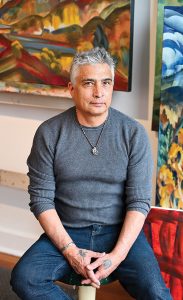
Tony Abeyta sits amidst his recent canvases in his studio during the spring of 2023.
“It’s about connecting to the information without being literal. It’s a challenge to paint a direct emotional response, not worrying about the process of making art and not trying to connect it to the external world. The truth is, it is an understatement to say that I’ve had to refrain from trying to make something in a painting into something recognizable. I’m an artist, so I see imagery within the abstract compositions. When creating these paintings, my internal connection to [the] muse needed to leave behind the skills and precision to make my art recognizable. My focus was not having any agenda to paint anything, just to create feelings and emotions.”

Many of Abeyta’s landscape paintings are inspired by New Mexico’s scenery. He executed this piece in his Modernist style.

Abeyta adds finishing touches to a painting in his Santa Fe studio.
Looking back at his career, Abeyta relates that age, time, and experience have shown him that one can develop not only as a human being but also within the world. He thinks about his legacy and his art. “I try to bring my experiences of the past into part of my personal narrative. Travel, nature, and connecting to nature is my way.”

Among the many works in Abeyta’s art collection is the 1971 lithograph Crucified by Fritz Scholder. Abeyta created the diptych on the wall behind it for a museum collection.
Perhaps it was Abeyta’s personal convictions that led him to new expressions in his work. Feeling that art is therapeutic, he says that for him as an artist, it is “an expression of oneself, a resolve of your own voice speaking through your art on your behalf. For me, personally, it is a way to spiritually connect with the Divine.”





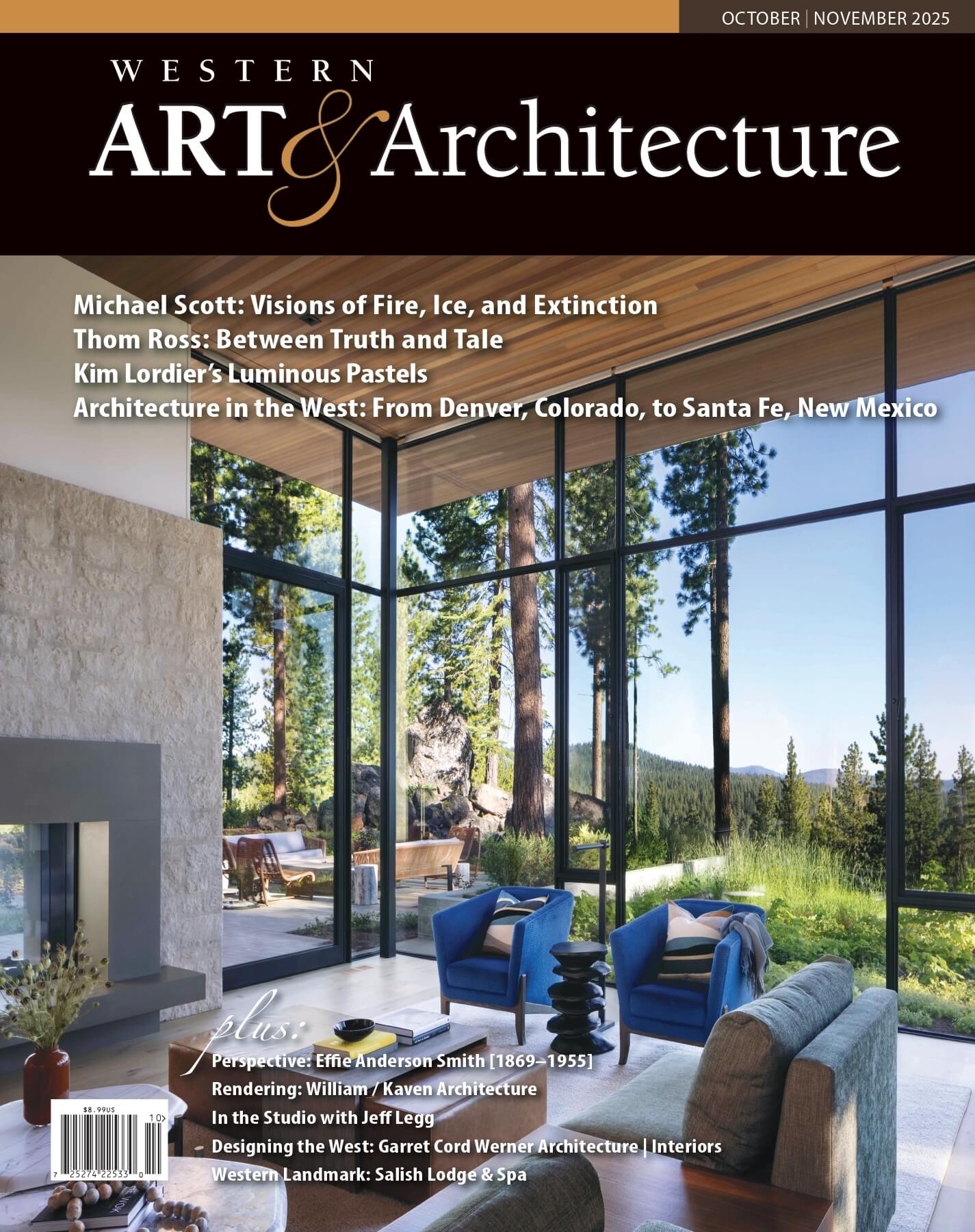
No Comments